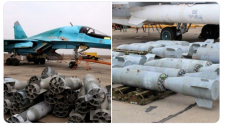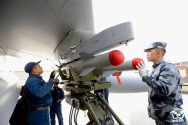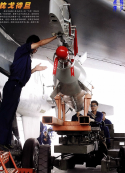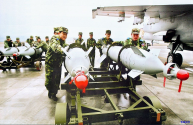View attachment 94676
1000kg laser guided something bomb, can't make out the something. Gross weight 1810kg each.
I think It is safe to assume that the plaaf is using some local variant of the GB1000 seen in many airshows.
View attachment 94676
1000kg laser guided something bomb, can't make out the something. Gross weight 1810kg each.




Has anyone done any in depth analysis of PLA munitions loading equipment and other ground support equipment (GSE) for jets? As I understand it, one of the major failing of the RuAF is that they have piss-poor GSE and GSE usage practice, which results in the bad habit of leaving munitions just lying around fully fueled jets:
View attachment 96229
A quick google for PLAAF GSE has stuff like mechanical autoloaders like these:View attachment 96230
and
View attachment 96233
But there are also images like this:
View attachment 96232
Which suggests that the PLAAF still uses a lot of "manual" loading practices - similar to the Russians. This can cause issues such as:
- Reduced sortie generation - the more time it takes to load fresh munitions on an airframe, the longer it'll take before the plane can take off again - to date, PLAAF rarely practices 12 turn 12 ops (send 12 jets up in a sortie before noon, and then send another 12 jets up after), instead relying on using different bases to generate the sortie volume that they're looking for. But this practice means the PLAAF operations are more like "lunges" than a continuous flow - they can launch a large number of airframes all at once, but it'll take a full day before they can launch again
- Increased response time - if the PLAAF doesn't do the (frankly retarded) RuAF practice of piling up munitions next to fully fueled aircrafts, then it may take the PLAAF more time to bring the munitions out of storage, bring the munitions to the airframes, and load munitions onto the airframes. This can increase the response time and leave the crew and airfields in a dangerous situation where they may be operating without an active CAP and are forced to rely on ground based SAMs.
Do you happen to know the dates the photos were taken? PLA today is vastly different than the PLA 10 years ago.Has anyone done any in depth analysis of PLA munitions loading equipment and other ground support equipment (GSE) for jets? As I understand it, one of the major failing of the RuAF is that they have piss-poor GSE and GSE usage practice, which results in the bad habit of leaving munitions just lying around fully fueled jets:
View attachment 96229
A quick google for PLAAF GSE has stuff like mechanical autoloaders like these:View attachment 96230
and
View attachment 96233
But there are also images like this:
View attachment 96232
Which suggests that the PLAAF still uses a lot of "manual" loading practices - similar to the Russians. This can cause issues such as:
- Reduced sortie generation - the more time it takes to load fresh munitions on an airframe, the longer it'll take before the plane can take off again - to date, PLAAF rarely practices 12 turn 12 ops (send 12 jets up in a sortie before noon, and then send another 12 jets up after), instead relying on using different bases to generate the sortie volume that they're looking for. But this practice means the PLAAF operations are more like "lunges" than a continuous flow - they can launch a large number of airframes all at once, but it'll take a full day before they can launch again
- Increased response time - if the PLAAF doesn't do the (frankly retarded) RuAF practice of piling up munitions next to fully fueled aircrafts, then it may take the PLAAF more time to bring the munitions out of storage, bring the munitions to the airframes, and load munitions onto the airframes. This can increase the response time and leave the crew and airfields in a dangerous situation where they may be operating without an active CAP and are forced to rely on ground based SAMs.
